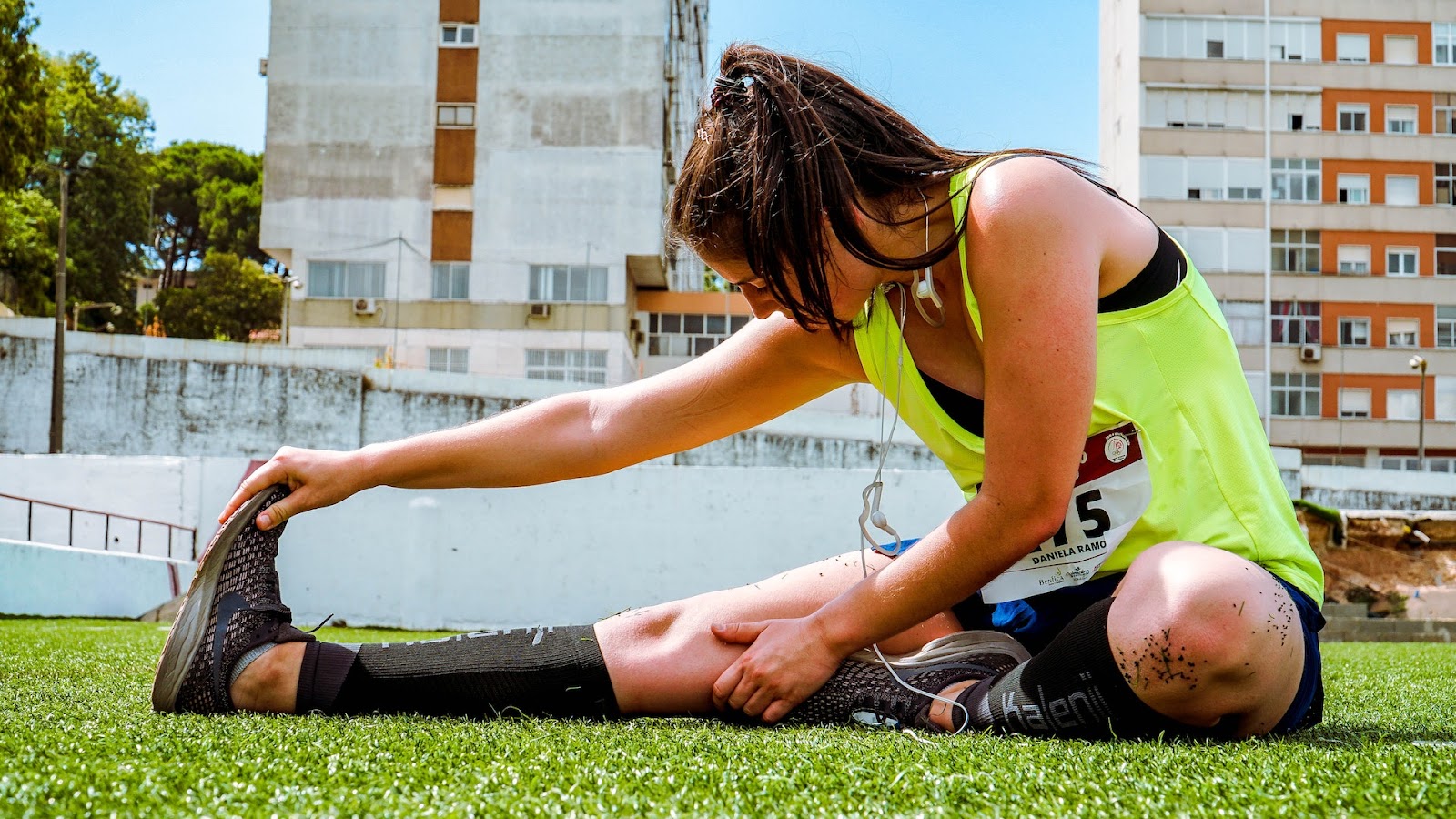Common mistakes people make when stretching can lead to more harm than good. Here are some of the most common mistakes people make when stretching:
| Holding the stretch for too long, which can lead to injury in muscles and joints. |
| Bouncing when stretching, which can cause small tears in the muscles and lead to soreness. |
| Stretching cold muscles, which can lead to injury or strain. |
| Overstretching, which can lead to hypermobility and instability of joints. |
| Not breathing deeply while stretching. |
| Rushing through stretches and not giving enough time for the target muscles to properly elongate. |
| Neglecting to stretch certain muscles, which can cause muscle imbalances and postural problems. |
To avoid these mistakes, it’s important to listen to your body, warm up before stretching, breathe deeply, and balance your stretching routine for all the muscle groups.
What Does Stretching do
Stretching provides many benefits and is an important part of any fitness routine. However, there are some common mistakes that people make when stretching which can lead to injury and can reduce the effectiveness of the stretch.
In this article, we will look at some of the most common mistakes people make when stretching and how you can avoid them.
Stretching Too Far or Too Hard
Stretching is a great way to prevent injury, improve flexibility, and promote relaxation. However, many people make common mistakes when stretching, which can lead to injury and discomfort.
| Mistake | Consequence |
| Bouncing | Can cause small tears in your muscles, leading to injury. |
| Overstretching | Can cause strain and result in painful muscle tears. |
| Holding your breath | Can increase tension and restrict oxygen flow to your muscles. |
| Not warming up | Can cause injury. Always warm up beforehand with light exercise, such as walking or cycling. |
| Incorrect form | Can lead to injuries, so make sure to learn proper form and technique from a certified instructor. |
Remember to listen to your body and avoid pushing beyond your limits. Stretch slowly and gently, and never force your body into a position it’s not ready for.
Holding the Stretch for Too Long
Holding a stretch for too long can lead to unnecessary pain and potential injury, especially if your form and technique are incorrect. Here are some common mistakes people make when stretching:
| Mistake | Explanation |
| Bouncing | Bouncing while stretching, also known as ballistic stretching, can cause your muscles to overstretch and lead to pain and injury. |
| Overstretching | Stretching beyond your limit can lead to pain and decreased mobility. It’s important to listen to your body and stretch to a comfortable level. |
| Incorrect form | Incorrect form and technique can lead to injury and negate the benefits of stretching. Make sure to keep your back straight, engage your core, and focus on the muscle being stretched. |
| Rushing through stretches | Rushing through stretches can lead to ineffective stretching and decreased mobility. Take your time and hold each stretch for at least 15-30 seconds. |
To avoid these common stretching mistakes, make sure to warm up before stretching, maintain proper form and technique, and listen to your body’s limits.

Bouncing or Jerking During the Stretch
Bouncing or jerking during the stretch is a common mistake people make when stretching, and it can lead to injury and muscle soreness. Here are some other common mistakes to avoid when stretching:
| Mistake | Avoidance |
| Holding the breath | It’s essential to breathe deeply and regularly during stretching to oxygenate the muscles fully. |
| Overstretching | Stretching should never cause pain or discomfort. Stretching beyond your limits can lead to muscle tears and sprains. |
| Not warming up | It’s essential to prepare your muscles for stretching by doing light exercises like jogging or jumping jacks. |
| Rushing through stretches | Stretching requires patience and attention to detail. Holding each stretch for at least 20-30 seconds allows the muscles to lengthen fully. |
| Incorrect posture | Poor posture during stretching can lead to ineffective results and potential injury. |
By avoiding these common stretching mistakes and maintaining proper form and technique, you can increase flexibility, reduce muscle soreness and the risk of injury.
Not Warming Up Properly Before Stretching
Stretching can be an important part of any workout routine, yet many people make common mistakes when stretching. One of the biggest mistakes people make when stretching is not warming up properly before they start.
Warming up helps to increase your body temperature and get your muscles ready for stretching. It is also important to ensure that you stretch slowly and gently to avoid injuries and maximize flexibility.
This article will focus on the importance of warming up before stretching and some of the most common mistakes people make when stretching.
Importance of Warm-Up Exercises
Warm-up exercises are crucial to prepare your body for physical activity and prevent injuries. Not warming up properly before stretching can lead to common mistakes that people make, such as:
| 1. Stretching cold muscles: | Stretching without prior warm-up can damage cold muscles and cause pain or strain. |
| 2. Skipping dynamic stretches: | Dynamic warm-up exercises, like jogging or jumping jacks, increase blood flow and loosen up the body, yet many people skip them. |
| 3. Overstretching: | Too much stretching or holding a stretch for too long can lead to muscle or joint injuries. |
| 4. Improper technique: | Incorrect stretching techniques, such as bouncing or twisting, can cause injury and pain. |
To avoid these mistakes, take the time to properly warm-up before stretching, including dynamic exercises and gentle stretches. Listen to your body, avoid overstretching, and learn proper techniques to prevent injury and get the most out of your exercise.
Dynamic Stretching Versus Static Stretching
One of the most common mistakes people make when stretching is not warming up properly before stretching. This can lead to muscle strains and other injuries.
Dynamic stretching and static stretching are two types of warm-up techniques that can help prevent such injuries.
Dynamic stretching involves actively moving through a range of motion, such as leg swings or arm circles. This helps to warm up the body and increase blood flow to the muscles.
In contrast, static stretching involves holding a stretch for an extended period, such as touching your toes and holding the stretch for 30 seconds. While static stretching can improve flexibility, it should be done after warming up with dynamic stretching or light activity.
By properly warming up before stretching and using a combination of dynamic and static stretching, you can reduce your risk of injury and improve your overall flexibility.

The Best Warm-Up Routines for Stretching
Not warming up properly before stretching is one of the most common mistakes people make while stretching. It can lead to muscle strains, decreased mobility, and an increased risk of injury. Here are some other common mistakes that people make when they stretch:
| 1. Bouncing: | Many people believe that bouncing in their stretches will help them go deeper, but it can actually cause micro-tears in the muscle fibers and lead to injury. |
| 2. Holding their breath: | Holding your breath while stretching can cause tension and make it harder to relax into the stretch. Remember to breathe deeply and rhythmically. |
| 3. Overstretching: | Going too deep into a stretch can cause injury, especially if you’re not warmed up properly. Start slowly and listen to your body’s cues to avoid injury. |
To avoid these common mistakes, it’s important to warm up properly before stretching and take your time getting into your stretches. Incorporating a dynamic warm-up routine that includes movement and raises your body temperature is key.
Skipping the Cooling-Down Phase
When it comes to stretching, it’s important to not just focus on the stretching phase. Another equally important phase of stretching is the cooling-down phase. This is the time to focus on holding the stretch to release tension, as well as engaging in some breathing exercises or mindful meditation. Unfortunately, many people make the mistake of skipping over this step, resulting in improper stretching and sometimes even injuries.
Let’s look into some common mistakes made when stretching.
Importance and Benefits of Cool-Downs
Cooling down after exercise is essential to reduce the risk of injury, muscle soreness, and help the body readjust to its resting state. Skipping the cooling-down phase after exercise can lead to tightness, decreased flexibility, and even fainting due to blood pooling.
Here are some common mistakes people make when stretching:
| Mistake | Consequences |
| Holding the stretch for too long | Stretching for an extended period can lead to muscle injury and soreness. It’s better to hold each stretch for 10-15 seconds, gradually increasing the duration with regular practice. |
| Overstretching | Stretching beyond the comfortable limit can lead to tissue damage and reduced flexibility in the long run. Be gentle and avoid bouncing or jerky movements. |
| Not breathing properly | Holding your breath during stretches can cause muscle tension and increase the risk of injury. Inhale deeply and exhale slowly during each stretch to improve oxygen flow and reduce stress. |
| Pushing through pain | Stretching should feel good, not painful. Listen to your body and stop if you feel discomfort or pain. Pushing beyond your limit can lead to muscle strain or tear. |
Taking time to avoid these stretching mistakes can help increase flexibility and range of motion while also preventing injuries.
Dynamic Versus Static Cool-Down Exercises
One of the most common mistakes people make when stretching is skipping the cooling-down phase, which involves doing dynamic or static exercises to bring your heart rate and breathing back to normal after an intense workout.
Dynamic stretching involves movement, such as walking or jogging in place, while static stretching involves holding poses for several seconds.
Here are some benefits of dynamic and static cool-down exercises:
| Dynamic cool-down exercises | Static cool-down exercises |
| Improve flexibility | Release tension in muscles |
| Increase blood flow to muscles | Improve range of motion |
| Reduce risk of injury |
To avoid injury, it is essential to incorporate both dynamic and static cool-down exercises in your routine and not skip this crucial phase.

Examples of Effective Cool-Down Exercises
One common mistake people make when stretching is skipping the cooling-down phase. Here are some effective cool-down exercises to incorporate in your stretching routine:
| Exercise | Description |
| Walking | A gentle walk for 5-10 minutes after exercise helps to relax the muscles and gradually reduce your heart rate. |
| Stretching | Include static stretches for 10-15 seconds, focusing on the muscles you used during your workout. Holding the stretches any longer than 15 seconds can lead to the muscles tensing up. |
| Yoga | Yoga is a great way to cool down as it helps with flexibility and relaxation. Incorporate some basic poses that focus on stretching the muscles you just worked on. |
| Foam rolling | Foam rolling helps to loosen tight muscles and prevent soreness. Spend about 5-10 minutes rolling out the muscles you worked on during your workout. |
Don’t skip the cooling-down phase to prevent your muscles from becoming tight and sore later.
Stretching the Wrong Muscles or Body Parts
Stretching is an important part of any fitness routine as it helps improve flexibility, manages stress, and improves overall health. However, many people make mistakes when stretching, particularly when it comes to stretching the wrong muscles or body parts.
This article will discuss some common mistakes people make when stretching and provide tips to help you stretch safely and effectively.
Common Mistakes in Targeting Specific Muscles
One of the most common mistakes people make when stretching is not targeting the correct muscle or body part, which can lead to injury or ineffective results. Here are some other common mistakes people make when stretching:
| Mistake | Explanation |
| Stretching without warming up | Stretching cold muscles can cause injury and discomfort. A quick warm-up such as jogging or jumping jacks can prepare your muscles for stretching. |
| Holding stretches too long | It is not necessary to hold a stretch for an extended period. Doing so can lead to a decrease in muscle tension and injury. |
| Stretching too aggressively | Overstretching can cause damage to muscles, joints, and ligaments. It is important to stretch gently and gradually. |
| Not breathing | Holding your breath during stretches can reduce oxygen flow to your muscles, making them less effective. |
| Neglecting certain muscle groups | Focusing only on the muscle groups you think need stretching can lead to muscle imbalances and posture issues. Be sure to stretch all muscle groups evenly. |
By avoiding these common mistakes and targeting the appropriate muscle areas when stretching, you can optimize your stretching routine and avoid injury.
Understanding and Identifying Your Body’s Muscles
One common mistake people make when stretching is focusing on the wrong muscles or body parts. To understand and identify your body’s muscles, it is important to learn about the major muscle groups and their functions.
| Tips | Explanation |
| 1. Learn about the major muscle groups in the body, such as the hamstrings, quadriceps, glutes, and calves. | Understand the function of each muscle group and how they work together. |
| 2. Identify the muscles that are causing pain or discomfort and focus on stretching those specific muscles. | Use proper form and technique when performing stretches to avoid injury or strain. |
By taking the time to understand and identify your body’s muscles, you can effectively target the areas that need stretching and avoid common mistakes.
Tips for Proper Muscle Targeting and Stretching Techniques
Stretching is a vital component of any fitness routine, but people often make some common mistakes that can lead to injury or ineffective muscle targeting. It’s important to be aware of these common mistakes before starting a stretching routine.
Some common mistakes people make when stretching are:
| Stretching cold muscles: | Stretching before warming up can lead to muscle strain or injury. Warming up before stretching can increase blood flow and prepare the muscles for a safe stretch. |
| Overstretching: | Holding a stretch for too long or stretching beyond your limit can cause muscle damage or strain. It’s important to listen to your body and only stretch to the point of mild discomfort. |
| Not targeting the right muscles: | Focusing on the wrong muscle or body part during a stretch can result in ineffective stretching and failure to achieve desired results. |
Pro tip: For proper muscle targeting and stretching technique, consider working with a personal trainer or physical therapist who can guide you through a tailored stretching routine for your specific needs.

Ignoring Pain or Unease during Stretching
Stretching is an important part of maintaining a fit and mobile lifestyle, but many people make mistakes when stretching that can create more harm than good. One of the most common mistakes people make is disregarding pain or unease during a stretch.
Understanding the right kind of pain associated with stretching and how to avoid injury can help you stay safe and maximize the benefits of stretching.
Identifying the Difference between Pain and Discomfort
One of the most common mistakes people make when stretching is ignoring pain or unease and confusing it with discomfort. The key difference between the two is that pain is a sharp or intense feeling that signals potential harm, while discomfort is a general sense of unease or tightness that can be relieved with a proper stretch.
Here are some tips to help you differentiate pain and discomfort during stretching:
| Discomfort | Pain |
| Often mild or moderate and decreases as you hold a stretch. | Intense and persists or worsens as you hold a stretch. |
| Feels like a burning or pulling sensation that is evenly distributed throughout the muscle. | Can feel sharp, stabbing, or localized in a specific area. |
Always listen to your body during stretching and stop if you feel any sharp or intense pain to avoid potential injury.
Understanding the Dangers of Stretching Through Pain
Stretching can be a great way to improve your flexibility, reduce muscle tension, and prevent injury, but ignoring pain or unease during stretching can lead to serious harm to your body. Here are some common mistakes people make when stretching:
| Bouncing: | Bouncing while stretching can cause muscle tears and damage. |
| Stretching too far: | Pushing your body too far beyond its limit while stretching can cause injury. |
| Overstretching: | Holding a stretch for too long can overstretch your muscles and strain your joints. |
| Not respecting your body’s limits: | Not listening to your body’s signals for pain or unease can lead to injury. |
By being aware of these common stretching mistakes, you can reduce the risk of injury and enjoy the full benefits of stretching without any harm.
Pro tip- Always stretch gently and gradually until you reach a point of slight tension, but never pain or discomfort.
Tips to Handle Pain or Unease During Stretching
When stretching, experiencing pain or unease is common, but it’s important to handle it correctly to prevent further injury. Here are some tips to help you manage pain and unease during your stretching routine:
| 1. Listen to your body: | If a stretch causes significant pain, stop right away. It’s better to modify a stretch or try a different one than risk injury. |
| 2. Breathe deeply and slowly: | Relax your body and focus on your breath. Deep breathing can help relieve tension and discomfort during stretching. |
| 3. Go slow and steady: | Do not force yourself into a stretch too quickly. Going slowly through the motion will help gradually increase flexibility and prevent pain or injury. |
Common mistakes to avoid when stretching include overstretching, bouncing in a stretch, and holding your breath. Remember to stretch safely and always listen to your body.
Pro tip: If you have a pre-existing condition, consult with your doctor or a licensed physical therapist before starting a stretching routine.
